19 of the Best Mobile Games That Don’t Need Internet
We may earn a commission from purchases you make after clicking links on this site. Learn more.If you’re on the move a lot, you’ll be used to long periods of time offline. Whether it’s a long-haul flight, overnight bus ride, or just too much time spent on the subway where radio waves fear to tread, having no Wi-Fi or cell service is common even in this day and age.
Thankfully, not having signal doesn’t mean you can’t play some of the best mobile games on the market. Intentionally or not, many developers have made great games that don’t need an internet connection at all.
I always keep a collection of them on my phone for whenever I have a bit of downtime and no internet, and these are the ones I’ve been returning to time and again.
Some of them are free, some aren’t. I’ve stayed away from those requiring continuous attention, or where you need to spend a lot on in-app purchases to make them enjoyable.
Without further ado, here are the best offline games to get you through your own long commutes or endless travel days. They’re all available on both iOS and Android, with no Wi-Fi needed!
Mindustry

Mindustry was one of those games that I first played on a desktop PC, unexpectedly loved, and immediately downloaded for mobile so I could keep playing it no matter where I was. It’s best described as tower defense meets factory builder, although that doesn’t really do it justice: it’s basically its own thing.
It starts out simple enough, with a useful tutorial and easy levels to help you understand the basics. Gather resources, automatically feed them into factories to create ammo and research new tech, and build defenses that are hopefully impervious to the waves of attackers that work their way through the landscape toward you.
Things soon start getting more frenetic, especially once more advanced attackers start showing up, and you always feel like you’re juuuust on the edge of seeing your base get overrun. New resources and technologies show up regularly, though, and finding the best ways of using them is key to your survival.
In later levels you don’t just get to sit back and decimate enemy attackers, you have to build your own units and go out to take on their base as well. Turning the tables like this requires quite a different mindset: all of a sudden, you’re the one trying to destroy supply lines while avoiding entrenched defenses.
There’s plenty more nuance and strategy involved, but I won’t spoil all the fun here: you’ll find out soon enough once you get into the game. The extensive campaign mode is completely playable offline, and trust me, you’ll get many, many hours out of that mode alone. Local multiplayer is also an option, and it’s even multi-platform: desktop, iOS, and Android devices can all participate.
Best of all, the game is free on Android, and cheap on iOS (and Steam), with no ads, in-app purchases, or other annoying distractions. Just go grab it already!
Vampire Survivors
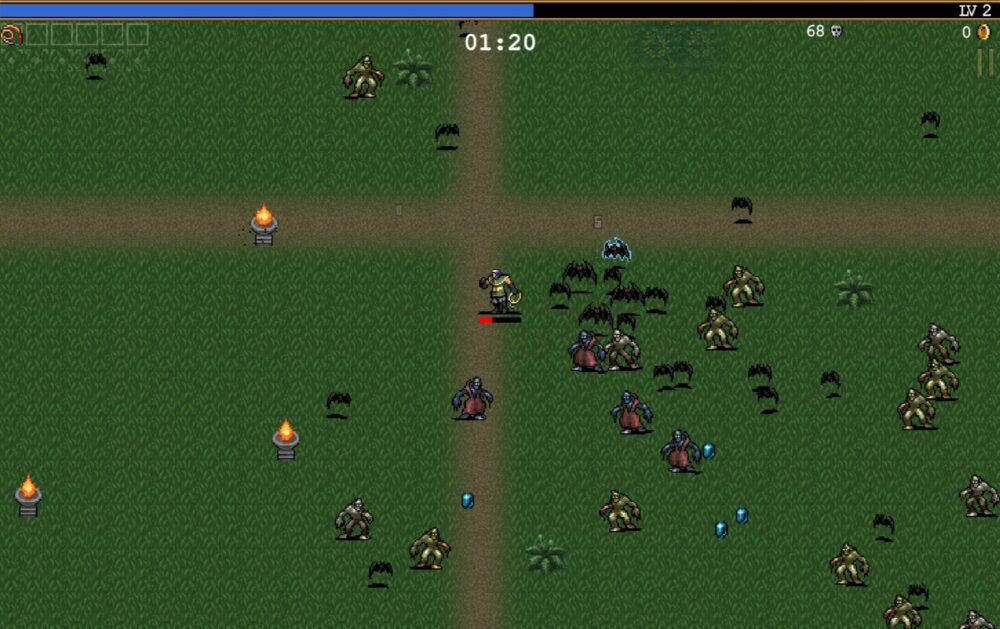
Vampire Survivors was an unexpected indie hit on PC in 2022, and has now sold something like ten million copies on desktop and mobile. Why was its success so unexpected? Well, the graphics and sound seem like something from the early nineties, and almost the entire game was coded by a single person.
I first played this on PC after seeing all the hype about it, and it took about five minutes before I was totally hooked. The gameplay and controls couldn’t be simpler (literally all you do is move, so you can play with one hand), and yet it’s incredibly, incredibly addictive.
All you do is select a character, run around killing enemies and collecting gems, then spend those gems on powerups. It’s like a million games before it in that regard, and yet there’s something about the perfect difficulty curve and ridiculous amounts of mayhem in later levels that got me totally hooked.
Each character has its own set of abilities that legitimately affect how you play, and the level designs create their own set of challenges as well. No game lasts longer than 30 minutes (you’ll see why when you get there), so there’s always time for just. one. more.
Or in my case, about 100 more until my phone goes flat at 2am. That’s not helped by the rougelite nature of this game, where you can spend in-game gold to buy permanent upgrades that make your starting character just a little stronger each time.
There’s a genuine sense of satisfaction when you choose just the right combination of weapons and powerups to turn yourself into an indestructible dealer of destruction. For about two minutes, until the difficulty ramps up a little higher and you find yourself in trouble yet again.
You can play in portrait or landscape, and the game is entirely free on mobile, works offline, and has no ads. The only thing you’ll pay for is extra downloadable levels and content, and even then, they’re only a couple of bucks each. Why are you still reading? Just go grab it now.
Monument Valley 2
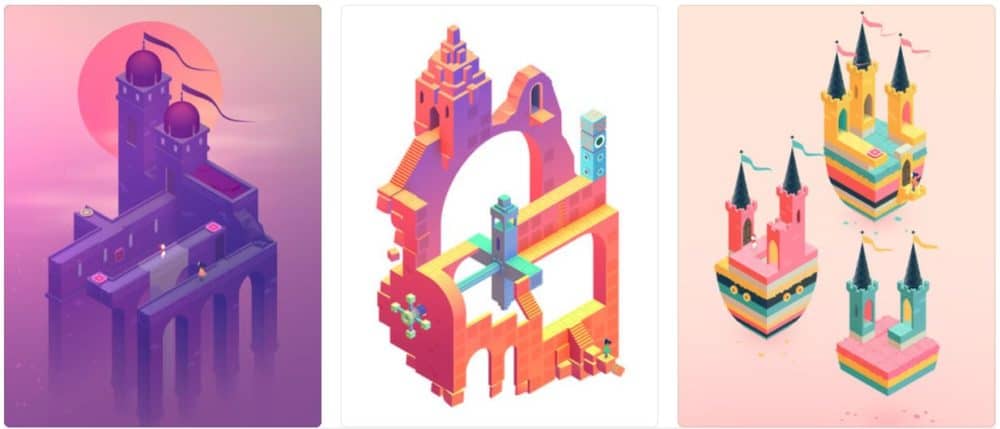
The original Monument Valley breathed fresh air into mobile gaming. It combined gorgeous graphics with challenging problems and wonderful, wordless storytelling in a way we’d never seen before.
Set in a colorful, Escher-inspired world, its only fault was that it was over all too quickly, leaving players desperately wanting more. Now they’ve got it.
The sequel delivers new levels and characters, but otherwise doesn’t tinker much with what made the first edition so good. It’s a mesmerizing experience, with puzzles that regularly convince you that you’ll never be able to solve them. Until you do.
Each level is different: sometimes you control both the mother and daughter characters, sometimes one or the other. Platforms move up and down, sections rotate, columns move around, and there’s suddenly a path to the exit that didn’t exist a second earlier.
It’s a game that’s far better to explore than to explain, easily worth the few dollars it costs. Don’t expect it to get you all the way through a transcontinental flight, though. Like the original, you’ll finish it in a few hours of dedicated play, and be left wanting more yet again.
So, when does the third version come out?
Dungeon Cards/Rogue Cards
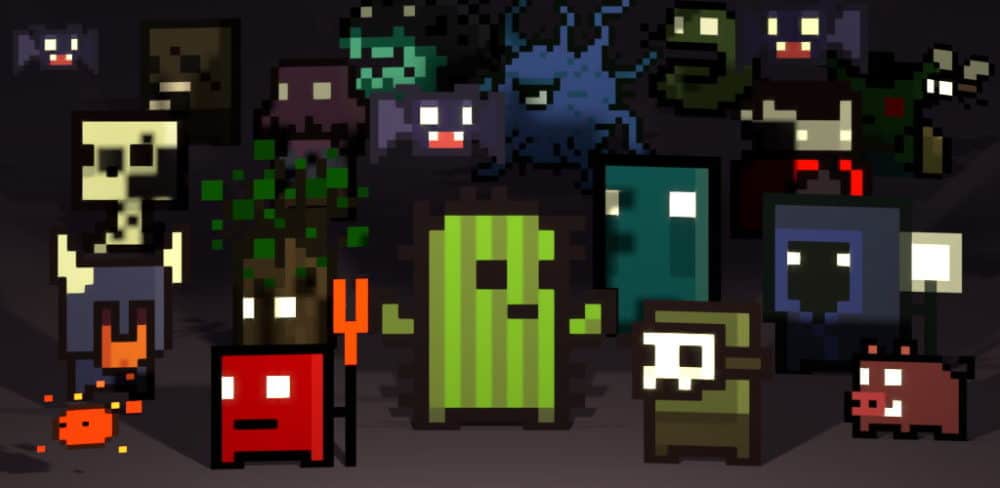
Definitely one of those games that’s simple to pick up and yet has a surprising amount of depth, I’ve spent far more hours playing Dungeon Cards recently than I care to admit.
Called Rogue Cards on iOS, the mechanic is straightforward: your character lives in a 3×3 or 4×4 “dungeon” filled with traps, chests, potions, weapons, enemies, and more. Moving into an enemy with a weapon in hand (usually) deals damage to them, attacking without a weapon deals damage to you as well.
On a very basic level, it’s as simple as that, but it’s the nuances that keep you coming back for more. Some weapons affect only one square, others impact an entire line or larger area. Chests can contain helpful or harmful items, while potions can have positive or negative effects, or none at all.
Each character has its own strengths and weaknesses, and they make a big difference in how you play. Characters, dungeons, and special powers are unlocked by collecting the gold and gems left when you kill an enemy, and the game changes significantly based on the combination of all three.
The pixel-art graphics are functional rather than beautiful, but they do the job just fine, and mean that Dungeon Cards will run on just about any phone you have. The game is free on Android, and while you can pay to unlock characters, there’s no particular need to if you’re happy putting hours into the game instead.
You can also watch an ad to double the amount of gold you receive at the end of the game, or pay a couple of bucks to receive it automatically. On iOS, you’re essentially paying the gold-doubling fee upfront when you buy the game.
Rummikub
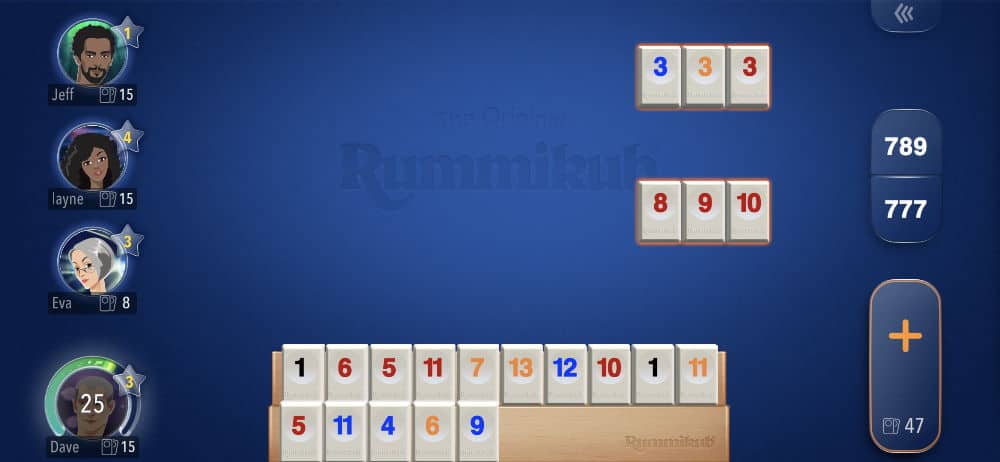
If you’ve never come across Rummikub before, it’s a 2-4 player game where you create sets of three or more numbered tiles in an attempt to clear your hand before your opponents. That’s a very simple description: there’s quite a bit more nuance and skill to it, especially in the later stages of the game!
I got introduced to the tabletop version of Rummikub a few months ago, and have been consistently playing the app version ever since. While it’s predominantly an online game against other human opponents, practice mode against the computer works perfectly offline.
Simply set a few parameters (number of players, difficulty level, and how long each turn can last), and away you go. Little features like being able to automatically sort your tiles into partial or complete sets saves a bunch of time, and it’s quick and easy to create, split, and move sets around.
While possible moves are limited and obvious in the early stages, things tend to get much more complicated towards the end. Because you can add to existing sets or split them into two or more new sets, far more potential moves become available, and the turn counter always seems to run down too quickly!
Rummikub is free to download and play, and you can play as many games as you like in practice mode. Online matches need “coins” to join, which you earn either by winning games, watching ads, or paying for them, but the developers haven’t gone overboard with the monetization attempts.
The Room: Old Sins
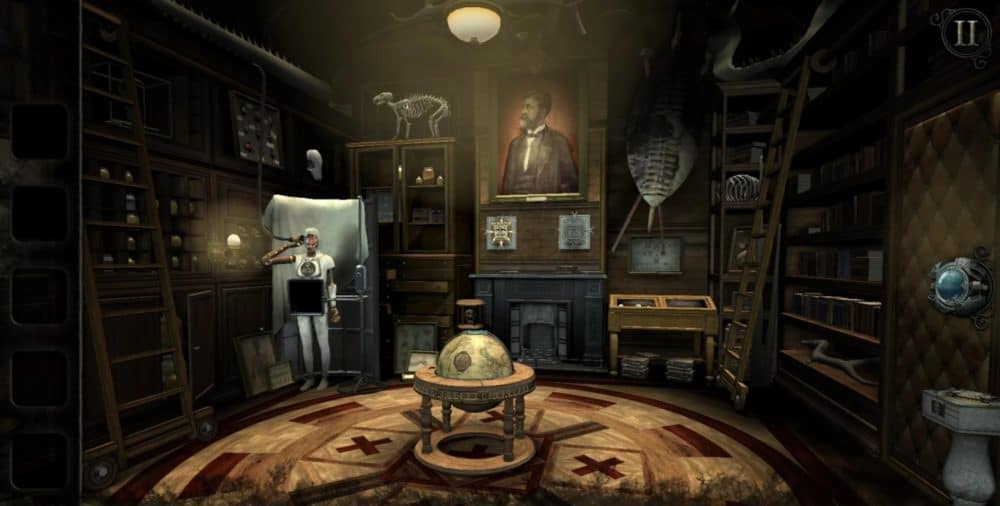
Released way back in the mists of time (ok, 2012), The Room quickly became a classic. One of those rare games that managed to be genuinely scary at times, the level of detail and difficulty meshed perfectly with the mysterious storyline, and made it arguably the best mobile puzzle game available.
This, the fourth edition in the series, follows right along from the previous three. An ambitious engineer and his wife have disappeared, and the trail leads right to the attic of their house. Inside lies a peculiar dollhouse… and that’s where the fun begins.
Every detail matters as you explore your new environment, and it’s easy to overlook something when you’re in a hurry. It almost feels like you’re really touching the objects you find, with hidden mechanisms and new clues waiting to be discovered as you examine them.
With its dark plot, atmospheric graphics, and haunting soundtrack, this is one game you’ll definitely want to play with headphones if you’ve got people around. Just try not to jump out of your seat too often!
Carcassonne
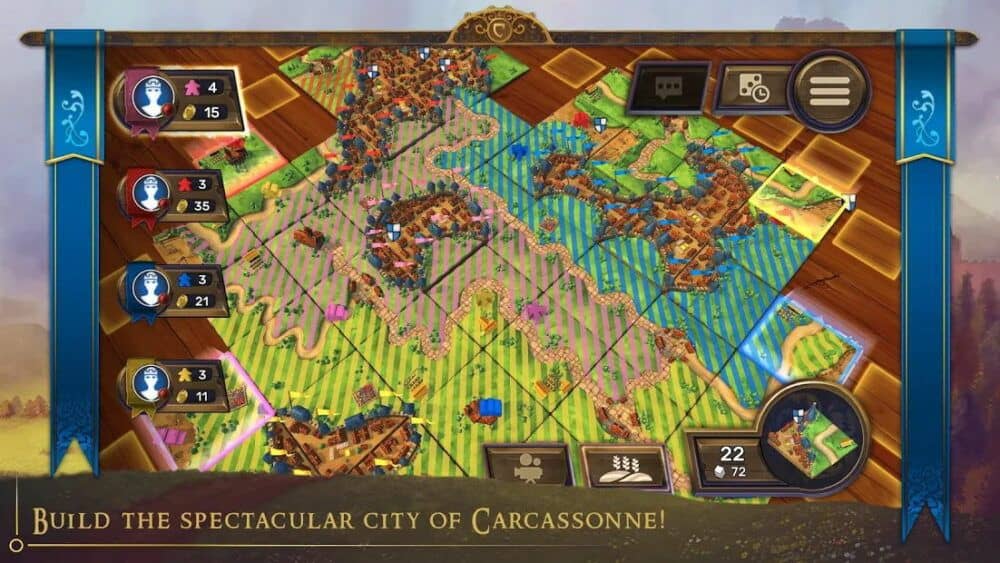
I first came across Carcassonne in its original board game form, a popular 2-5 player game where you join tiles to create roads, rivers, cities, and meadows, then make the best use of a limited number of pieces to outscore your opposition. It’s the perfect way to while away a rainy Sunday afternoon, and my girlfriend and I have played many, many hours of it.
Since the board game is a bit too large to fit in my day bag or play on the train, I was very happy to discover the app-based version, and even happier to find out how good it was. Bright and colorful, the 3D landscapes look great, and the game is easy to pick up and play whether you’re a Carcassonne veteran or coming to it for the first time.
All of the usual features are there, including various expansion packs like Inns and Cathedrals and The Princess and the Dragon which bring fun new elements to the standard game. Multiplayer mode can be a bit buggy, but Solo mode (which works offline) has never given me any problems.
In it, you can choose between one or two AI opponents and select their playing style. There’s a noticeable difference between Aggressive and Builder, for instance, and you’ll need to change your own approach to win.
The base game costs $5-$6, and you can unlock one of the expansions by creating an account. It’s perfectly playable like that for as long as you like, but if you want to mix things up with the other expansions, they’ll set you back a few dollars each.
Really Bad Chess
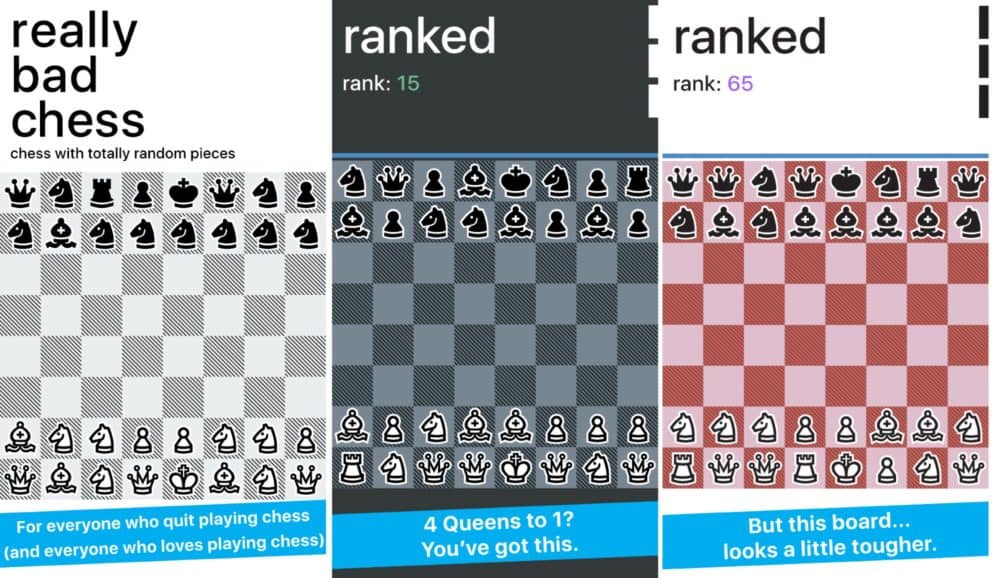
If there’s one thing I know how to do, it’s play really bad chess. The developer of this game felt the same way, so decided to make his own version — with one big difference.
While the board and rules are all the same, the starting pieces are entirely different for both players. It looks a lot like what you’d get if you put a few hundred chess pieces in a bag, shook them around, and pulled them out at random. Three queens, six knights, and a scattering of pawns? Sure, sounds great.
Playing against the AI (or if you pay for the unlocked version, someone sitting beside you), the random assortment of pieces helps even things up, and lets even novice players have a decent chance of success.
As you get better, you rise up the rankings, which means that although the pieces stay random, their quality changes. The overwhelming advantage you had against the computer swings the other way, and winning gets much harder.
People with no chess experience say it’s helped them learn the (proper) game, and as someone who has played a bit in the past, I’ve found myself enjoying the new approach a lot more than I’d expected. If you’ve always liked the idea of chess, but never managed to get into it, it’s well worth the download.
FlipFlop Solitaire
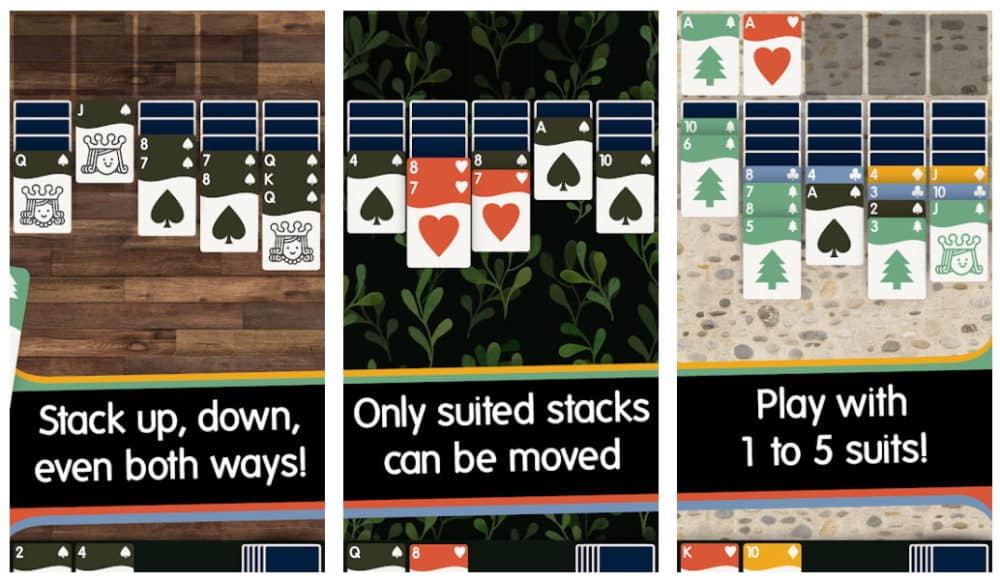
From the same developer (Zach Gage) as Really Bad Chess comes Flipflop Solitaire, another successful attempt at making a traditional old-school game less frustrating and a lot more fun.
I played a lot of Klondike Solitaire as a kid (you know, the one that comes with Windows), and while it was better than, say, doing my homework, it really wasn’t all that enjoyable after a while. Some games just weren’t winnable no matter what you did, which kinda sucks to realize when you’re several minutes in.
Flipflop Solitaire takes a different approach. You’ve got five piles of cards, and can stack cards in ascending or descending order as you like. Suit or color don’t matter, and you can move any card or stack to an empty column, not just the kings. Sounds easy, right? Not so fast.
The trick is that you can only move a stack when all the cards are of the same suit and in order. So, while you have lots of flexibility about how you move cards around, it’s easy to dig yourself into a longer-term hole by taking a short-term win. Trust me, I’ve done it. Often.
The difficulty levels are smartly done as well: rather than arbitrary easy/medium/hard, you just choose how many suits you’d like. Winning with a single suit is reasonably easy once you get the hang of things. Winning with five suits is… not.
Each game is over quickly, but the temptation to keep playing will likely last longer than your phone battery. Most parts are free, with unobtrusive ads popping up every few games if you’re online. To remove ads, play at a couple of higher difficulties, and tweak the appearance, you can pay a very reasonable $2.99.
Mini Metro
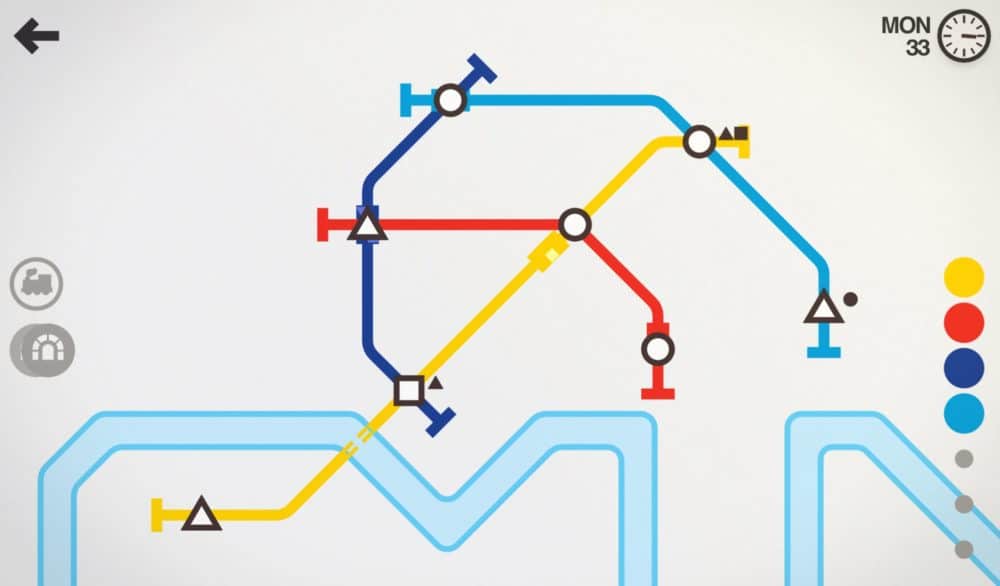
Ever had a strange desire to run your own subway system? No, neither have I, but that hasn’t seemed to stop me playing a lot of Mini Metro.
Based very loosely around the maps of various major cities like London, New York, and Paris, the idea is to build a functioning metro to service your ever-growing population. You start with a limited number of trains, carriages, lines, and tunnels, and need to intelligently deploy them as the city grows. You’ll gain a few extras and upgrades if you last long enough, but they never quite feel like enough to get ahead for long.
It’s deceptively simple in the early stages, but that changes quickly as new population centers pop up. With more people using the network, it gets progressively harder to avoid the overcrowding that ends the standard game. You can also play in endless mode, which switches off overcrowding for a more relaxing experience.
The minimalist graphics and soundtrack do their job well, and once you’ve bought the game, there are no ads or in-app purchases to contend with. Each game is randomly generated for endless replayability, and the developers have even included colorblind and night modes.
Also available for Windows, Mac, and Linux, Mini Metro has won a bunch of awards and sold over a million copies on mobile alone. It’s not hard to see why.
Two Dots
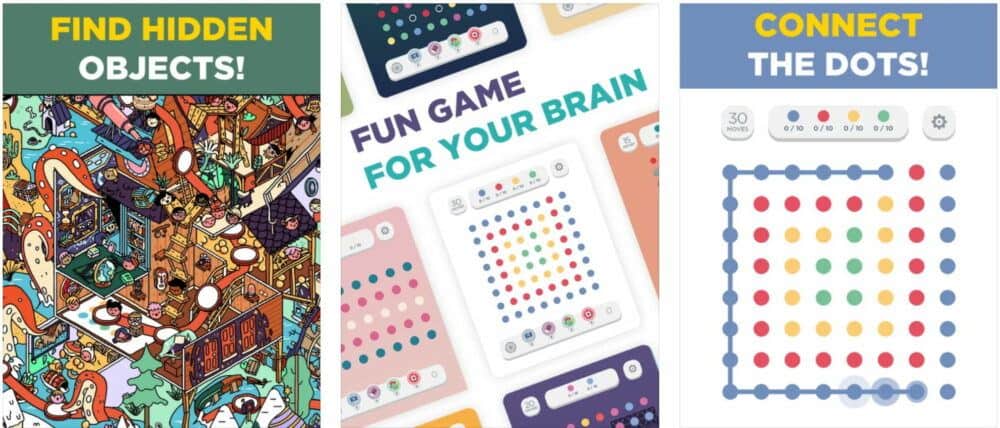
Two Dots is one of those games that sounds simple, perhaps even a little dull on paper, and then turns into a multi-hour gaming marathon that only ends when your phone battery goes flat.
Successor to the popular “Dots” game from a decade or so ago, the basic game mechanics couldn’t be more straightforward: join dots of the same color. That’s it. Connecting two or more dots makes them disappear, and joining them up in a square (or other shape) makes all dots of that color disappear.
Where things get interesting is the wide variety of levels, quests, and side games, and the dozens of different critters and obstacles that also inhabit your game board. In the main part of the game, you have a certain number of moves to complete each level, and a number of tasks to perform before the counter reaches zero. The faster you do it, the more points you get and stars you receive for that level.
Head off to the side quests, though, and things work a bit differently. These change every few days, and usually consist of clearing around seven levels of increasing difficulty, based around a particular theme. You can also compete for the highest score against other players, and there are even “Where’s Waldo?”-style levels where you have to identify dozens of specific items on a beautiful, highly-detailed board that’s chock-full of distractions.
Powerups abound, either earned through gameplay and stringing level wins together, or purchased in-app. The nagging to spend real money isn’t excessive, at least by the standards of apps like these, and there’s no need to pay anything to progress.
Throw in a chilled-out soundtrack and regular updates, and you’ve got a recipe for a game that you’ll keep coming back to time and time again. I know I do.
RollerCoaster Tycoon Classic

Did you ever play any of the games in the RollerCoaster Tycoon series? Released nearly two decades ago, you played the part of an amusement park owner.
Your job was designing the perfect combination of rides, facilities, and experiences to keep customers happy and money rolling in. Or making evil roller coasters that terrified their riders and make them throw up all over the park. I know which one I went for.
Many, many years later, we’ve finally got a good mobile version. Unlike so many adaptions of classic games to the small screen, this one isn’t awful. In fact, it’s really surprisingly good.
It combines the first two games in the series, staying very faithful to the original gameplay and graphical style. Expansion packs are available via in-app purchase, but thankfully there are no other IAP once you’ve bought the game. The fun factor and value for money are off the charts.
You can use pre-made roller coasters or design your own piece by piece, as you work your way through close to 100 different scenarios.
Throw in all the other parts of the game, from footpaths to food and drink stands, dozens of different kinds of rides (including water-based ones), hiring and firing staff, and trying to turn a profit, and you’ve got a game that’ll likely stay installed on your phone or tablet for years.
Eternium
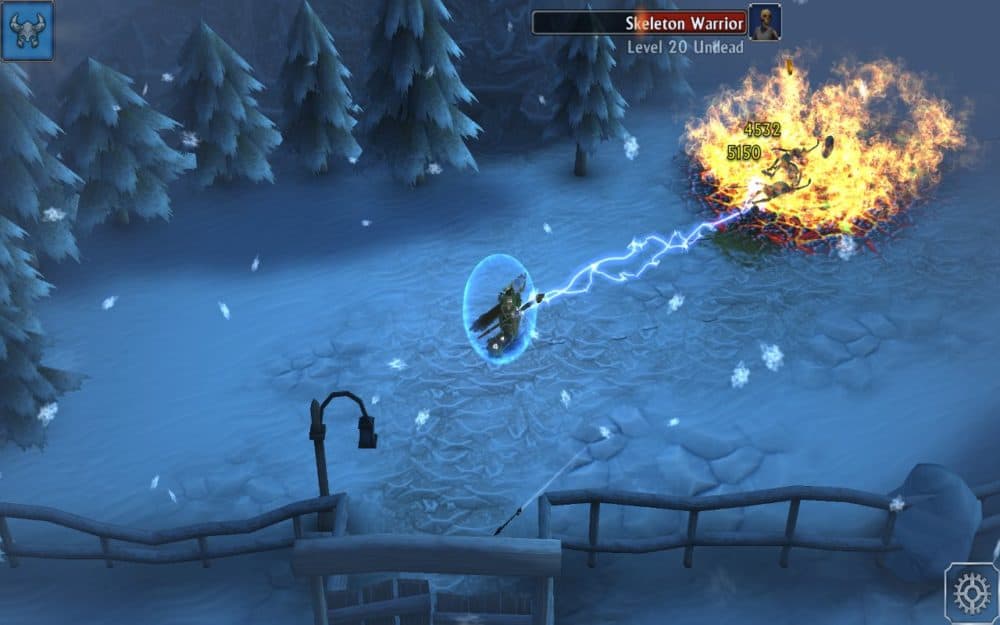
For those who like role-playing games (RPG), long-time favorite Eternium still ranks as one of the best offline options several years after its release.
Developed by old-school RPG fans, it’s received consistent, major updates ever since it first came out. Even better, it stays away from the annoying pay-to-win approach of many of its competitors.
If you enjoyed any of the Diablo games, you’ll be in your element here. Choosing to play as a warrior, bounty hunter, or mage, you battle a vast array of enemies to gain experience and level up, opening chests to get gold, gems, and equipment along the way.
Joining up with NPC characters, upgrading your gear, crafting unwanted items into things you actually need, it’s all there.
The game has three different worlds, each with different quests and enemies. There are endless randomly-generated levels, with most game features accessible offline after the initial download.
With gorgeous graphics and an intuitive interface, including drawing symbols on the screen to cast spells instead of mashing buttons, you can tell a lot of work has gone into this game. If you’re into genuine RPGs without endless micro-transactions, give it a try.
Infinity Loop

Want to play something relaxing to take your mind off the mayhem all around you? Infinity Loop is the answer. The concept is very simple: tap on puzzle pieces to rotate them, connect all the lines, and close the loops.
The graphics and sounds are about as minimalist as it gets. That suits the game perfectly and means it doesn’t drain your battery. There’s a very basic tutorial, and then you’re on your own. With such simple gameplay and controls, there’s no need for anything more.
Levels get slowly more difficult up to a point, and developers say there’s an infinite number of them. There’s also a “dark mode” that gets you to break all the loops instead of creating them. Suffice to say you’ll never get bored, no matter how long you’re stuck in the transit lounge for.
You can play for as long as you like without spending any money, making this one of the best free offline games out there. If you’re enjoying it, though, you’ve got the option of paying anything from $1.99 upwards to remove ads and support the developers.
The Battle of Polytopia
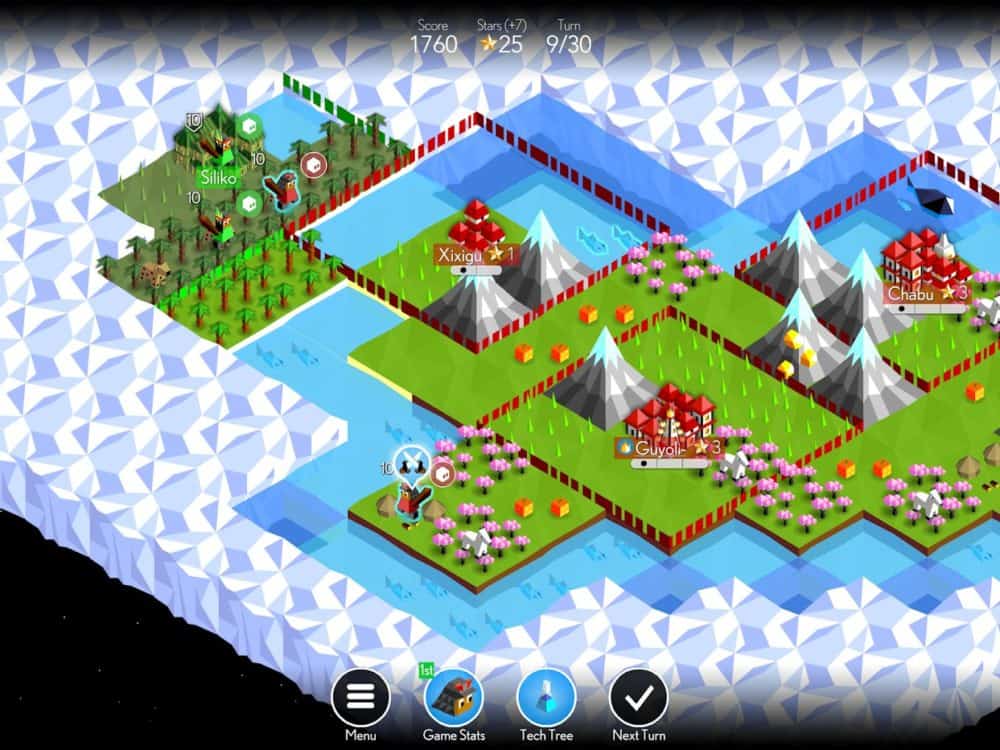
I don’t even want to know how many hours of my life I’ve lost to various Civilization games, but it has to be well into the thousands. For years, I’ve been looking for an equivalent world builder on mobile, and not finding it. Even the official Civ apps weren’t that great. Sad face.
And then I discovered The Battle of Polytopia. It’s not Civilization, and it doesn’t try to be, but it’s a fun and engrossing strategy game in its own right, and a great way to kill a few hours.
You start out with a handful of tribes to choose between, each of which starts with a particular technology. Other tribes can be unlocked for a dollar or two, with more advanced tech or other advantages.
Whatever you choose, you’ll be dropped into a land you can only see a small part of, with a single unit and city. You’ll then go about exploring the world, exploiting resources, upgrading your technology, and interacting with (ie, attacking) other tribes.
There’s a 30-turn version for quick games, and an endless mode ideal for long-haul flights, where the goal is to take over every city on the map.
Unusually for these type of games, it doesn’t suffer from being squeezed into the confines of a phone screen. The graphics are colorful and easy to understand, and the control mechanism is straightforward even on a large, busy map.
I don’t remember Polytopia ever crashing on me in several dozen of hours of gameplay. If you’re into world-building games, download it now.
Plague Inc

I wouldn’t usually include Plague Inc in this group, since it’s been around for so long. It keeps getting regular updates, however, and after reinstalling it recently, I was impressed by the latest additions. It’s definitely as addictive as it ever was, with an unfortunate new relevance since early 2020.
Rather than trying to save the world, most of the time you’re attempting to do the exact opposite: use a pathogen to kill everybody on the planet. Each of the dozen unlockable disease types has different strengths and weaknesses, and the game plays very differently depending on which one you’ve chosen.
As your disease spreads from country to country by air, land, and sea, you’ll need to keep carefully evolving it to stay one step ahead of the medical researchers desperately trying to develop a cure.
Graphics and sounds are functional rather than beautiful, but it’s the addictive gameplay, perfect difficulty curve, and dark sense of humour that have made it one of the most popular games on both app stores, downloaded millions of times. You can play a limited version for free, but it’s worth paying for some of the extras to unlock the full edition.
In homage to what we’ve all been dealing with in recent years, the creators of Plague released a new add-on: The Cure. In it you switch roles, racing against time to contain a pandemic with mask mandates and lockdowns and find a vaccine before the entire world gets infected. Sound familiar?
Pickle Pete: Survivor
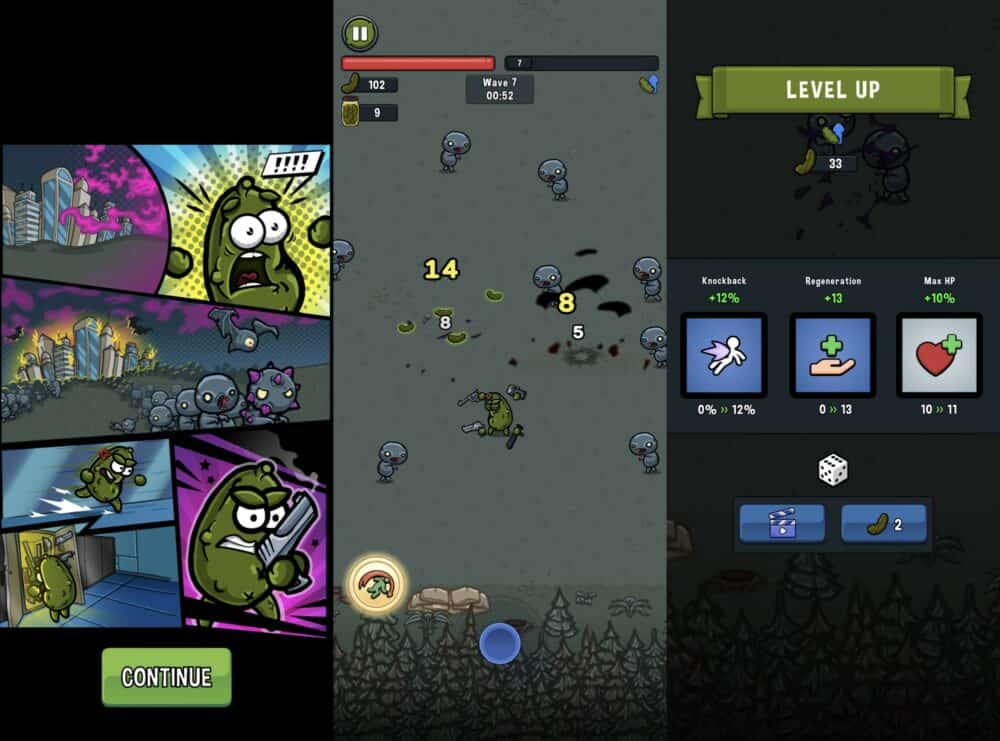
After a shocking industrial accident at the pickle factory turns the population of the nearby town into mutant zombies, there’s only one man who can save the world. If that’s not enough of a backstory, well, I just don’t know what to offer you.
You start out with a basic gun and a few slow-moving zombies, which turn into pickles when they die. Collect the pickles to spend on powerups at the start of each level, ranging from better weapons to a larger pickup radius, faster movement and healing, armor, and plenty more.
You’ll need those improvements pretty quickly: while the game starts off easy enough, it doesn’t stay that way. The playing area is just large enough to give you space to outflank and outrun enemies for a while, but you’ll never be able to stay out of harms way for long.
More than once I’ve found myself low on health, desperately dodging enemies and bullets while I try to run out the clock to finish the level. Sometimes that tactic works. Other times it…does not. At all.
There are some definite similarities to Vampire Survivors above (it’s an auto-shooter with simple controls), but it has a very different vibe. The graphics are more polished, powerups are handled differently, and it somehow manages to feel even more frenetic despite the much shorter timed waves.
Once you get to the end of a level, there’ll be a boss fight that varies between hard and damn near impossible. Win that, and along with a bunch of unlocks and powerups, a new level opens up with different enemies, gear, and all the rest.
Like all good rouge-like games, you can upgrade your character between games, using coins you’ve earned along the way. Add a bit of extra move speed or some additional melee damage and who knows, it might just be enough to get past the laser-spewing enemy that killed you last time.
It’s not the most original of games, but it’s well designed, lots of fun, and easily tackled in short, bite-sized pieces. I’m a fan.
I Love Hue Too
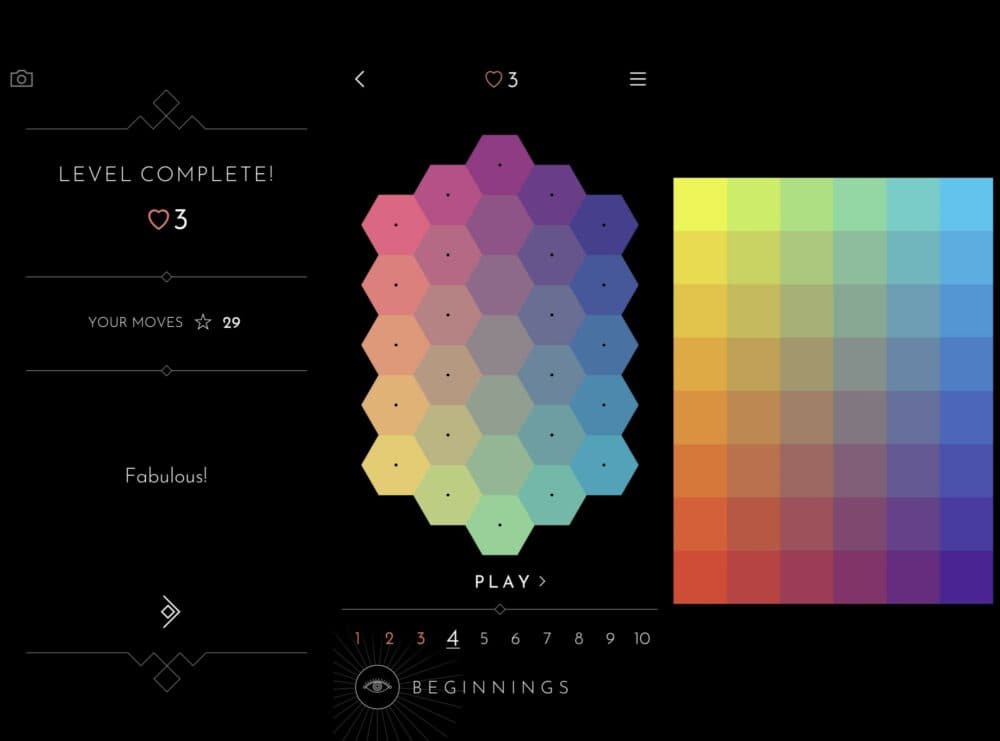
Looking for something a little more relaxed? I Love Hue Too (say it out loud) is one of those super-chilled puzzle games that you can dip in and out of: it’s engrossing and addictive, but each level is pretty short. You’re not going to miss your stop or stay awake all through the night on a long-haul flight. Probably.
The concept is simple: move blocks of different colors and shades around so that they fit into predefined gradients. That’s literally it, and yet while it starts off simple enough, it quickly gets a lot harder. Hints are available on each level, but they’ll add three extra moves to your finishing score.
The design is sparse but beautiful, with a calming soundtrack that’s particularly lovely through a set of headphones. The later levels are definitely more difficult if you’re colorblind like me, but not to the point where I found it unplayable. I just had to look harder at the screen to figure out the subtle differences!
With hundreds of levels on offer, plus the ability to replay any you’ve already completed to try for a better score, it’s not a game you’ll finish in a hurry. Ads are present but not intrusive, and you can pay a few bucks to get rid of them and support the developer if you want to.
Give it a go and let me know what you think!
Grim Tides: Old School RPG
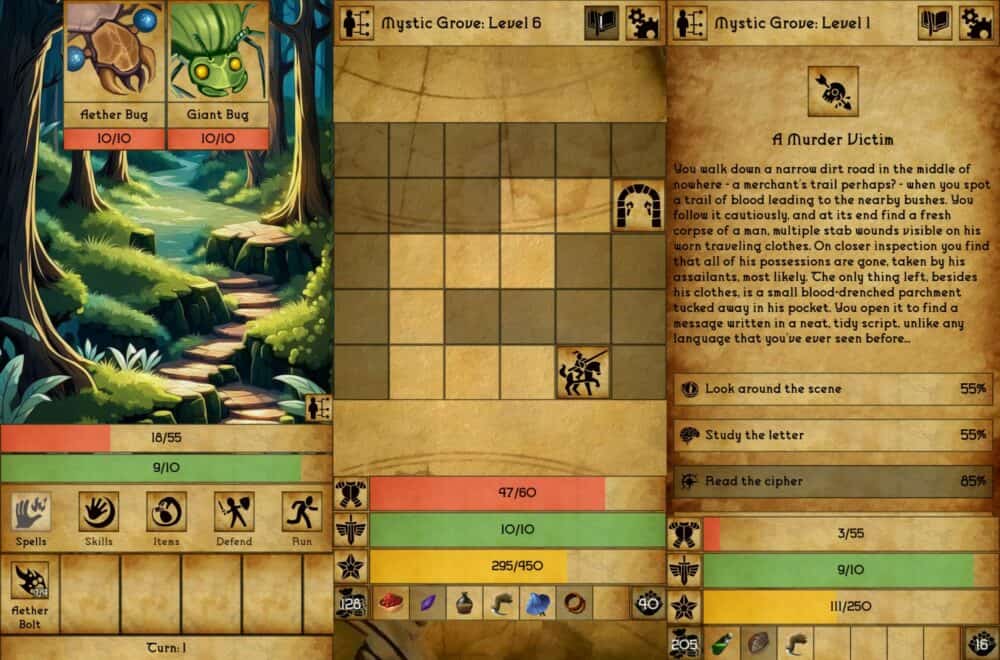
Back in the mists of time when I was a teenager, I used to play a lot of role-playing games. Many drew on familiar Dungeons and Dragons tropes: you could play as a warrior, mage, thief, and so on, crawling dungeons, finding treasure and enemies, and upgrading the gear, skills, and spells that kept you alive.
I hadn’t come across a mobile game that really managed to recreate that experience until recently, when I stumbled across Grim Tides. The clue was in the subtitle, I guess! If you’re a fan of this type of game, you’ll love it: it felt instantly familiar, easy to pick up but with loads of hidden complexities that let you really customize each run.
Starting out as a simple character with few skills, minimal equipment, and little idea about what’s going on, the storyline expands as you explore. Before long you’ll be throwing fireballs at or slicing through groups of enemies, mixing ingredients to make powerful concoctions, and exploring new lands.
There’s a huge amount of depth on offer, and while the dungeon and combat graphics are relatively simple, they’re more than enough to get the job done. Ads show up now and again: you can pay to remove them, but they’re not excessive and (so far at least) don’t appear when you’re offline anyway.
I’ve found it very easy to lose track of time as I battle away, trying new tactics and upgrades to get through that last annoying dungeon level. If you’re on a longhaul flight, pack your charging cable, settle in, and watch the hours disappear.
Any other games you love that don’t need Wi-Fi? Tell me all about them!
Main image via StockSnap, all others via the respective game developers.









My longtime favourite is Solomon’s Boneyard (see also: Solomon’s Keep!). I’ll have to check out Eternium because it might be similar — you pick a wizard that controls a specific element (magic balls, lightning, fire, ice) and see how long you can last a graveyard shift. I guess it’s kind of a rogue-lite where you earn upgrades within each game but also persistent upgrades, like magic rings and additional unlockable characters (steam, storm, fireballs, balls of lightning, balls of ice, firestorm… awesome combos of the original elements.)
I also used to enjoy Tilt to Live, which I think is offline too.
Donut county is a fun little puzzle game, and Lux Touch is mobile risk that’s played quickly.
Fun
Thank you great list. My job entails hours a day in an area with no internet and with very little to do. Lol hours of bordom, minutes of stress seconds of shear terror !
Some of these are going to be life savers!
I hope these help get you through! 😁
I’ve put hours upon hours into Fallout Shelter. You build a Fallout Shelter and add rooms to it Electric, Water, Food, and if you add a man and woman to a room they will have a baby. The baby will grow up and you can add them to an area to help with the shelter. Outsiders come and attack if you take them out sometimes you can loot the body to get new weapons. There’s a lot more to it but thats kind of sums it up. Thank you for the list I’m down loading some now!
Oh man, I spent so much time on Fallout Shelter a few years ago! Very fun game — thanks for the reminder!